Application of remote sensing imagery and algorithms in Google earth engine platform for drought assessment
In Vietnam, drought is one of the natural disasters caused by high
temperatures and lack of precipitation, especially with El Nino and the
global warming phenomenon. It affects directly environmental,
economical, social issues, and the lives of humans. Many methods have
been used to assess drought, in which remote sensing indices are
considered the most commonly used tool today. They are used to analyze
spatio-temporal distribution of drought conditions and identify drought
severity. Especially with the launch of Google Earth Engine (GEE) - a
cloud-based platform for geospatial analysis, it is easy to access highperformance computing resources for processing multi-temporal satellite
data online. With the GEE platform, we focus on writing and running
scripts with the indicators suitable for evaluating drought phenomenon,
instead of calculating on software and downloading remote sensing
imagery with large size. In this study, we collected 26 Landsat 8 images in
the dry season in 2019 (from April to July) in Tay Hoa district, Phu Yen –
a region in the South Central Coast of Vietnam where agricultural
drought occurs frequently. We assessed the distribution of drought
conditions by using a drought index (VHI index – Vegetation Health Index)
produced from Landsat satellite data in the GEE platform. The study
results indicated that the drought (from mild to severe) concentrated in
the North of the region, corresponding to high surface temperature and
NDVI low or NDVI moderate values. VHI maps were visually compared
with the drought map of the South Central Coast and the Central
Highlands. In general, the results also reflect the the method’s reliability
and can be used to support the managers to plan policies, making longterm plans to cope with climate change in the future at Tay Hoa in
particular and other regions in general.
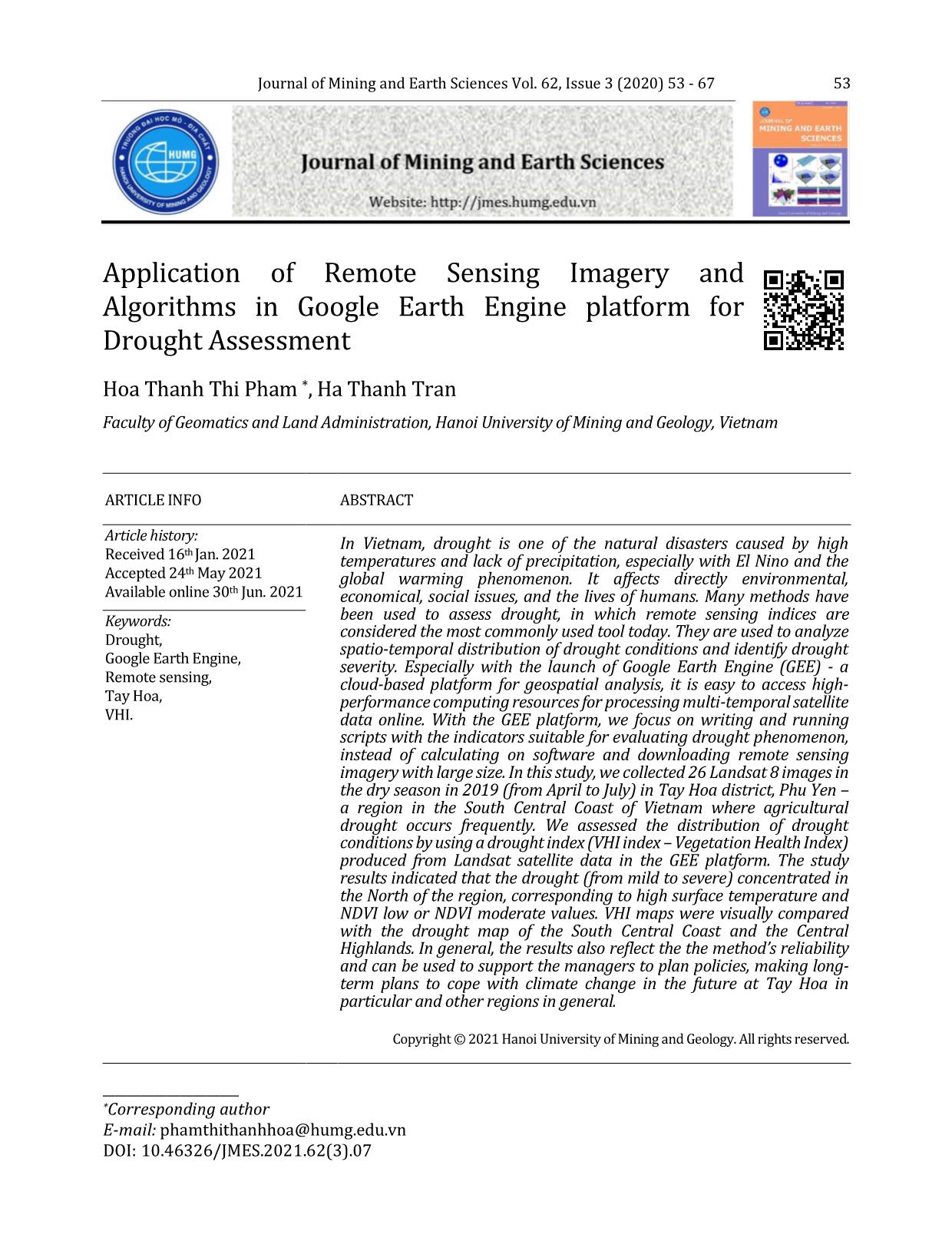
Trang 1
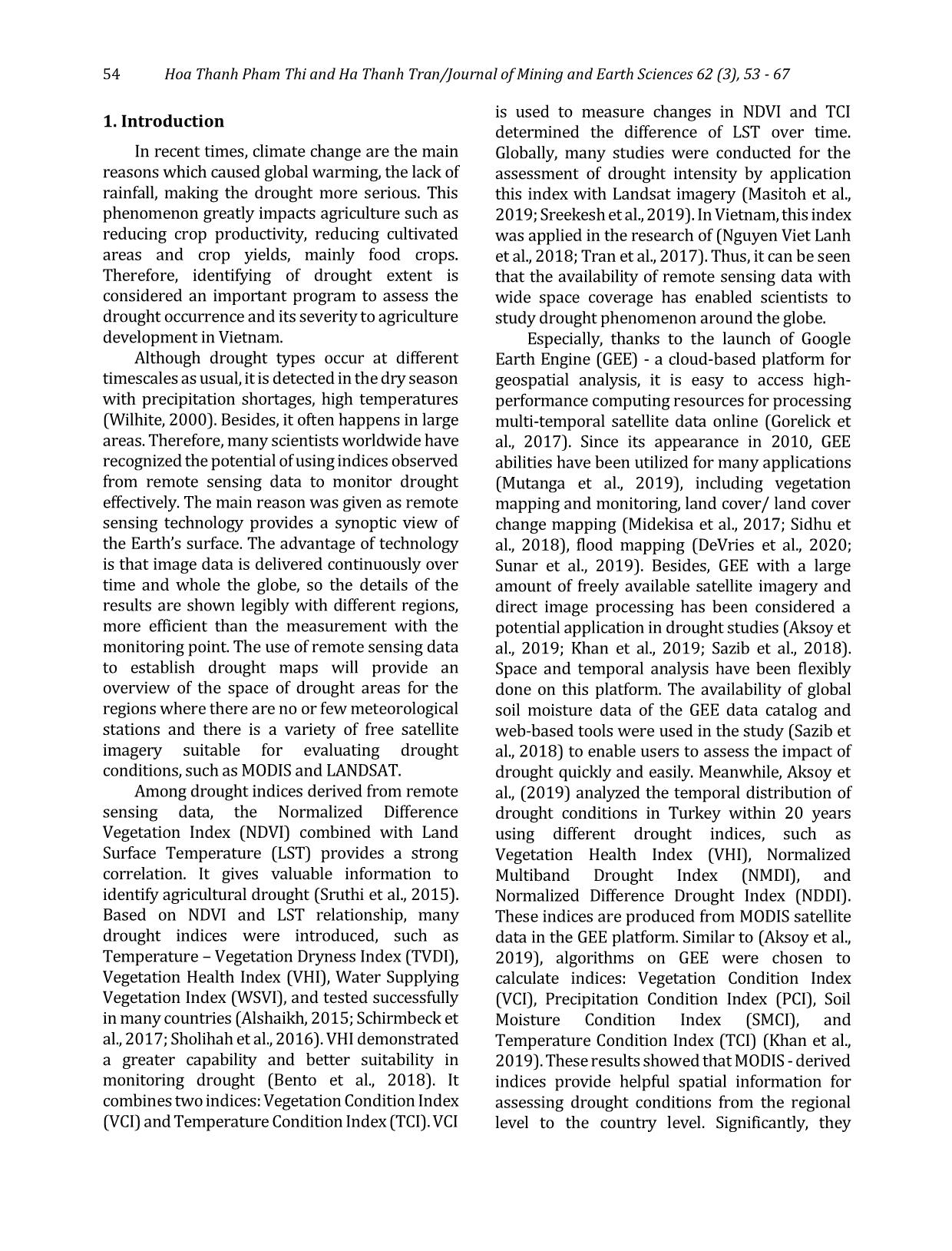
Trang 2
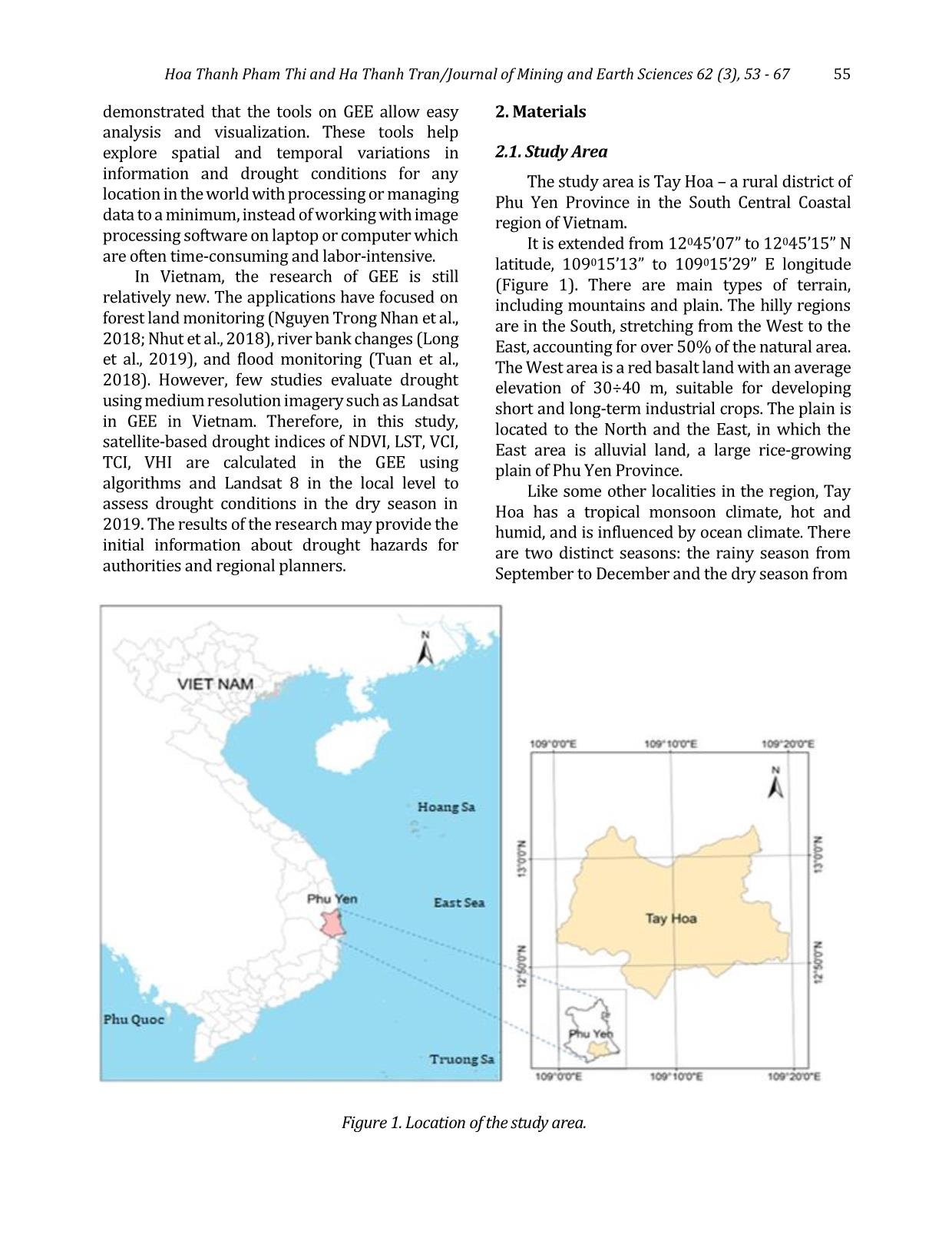
Trang 3
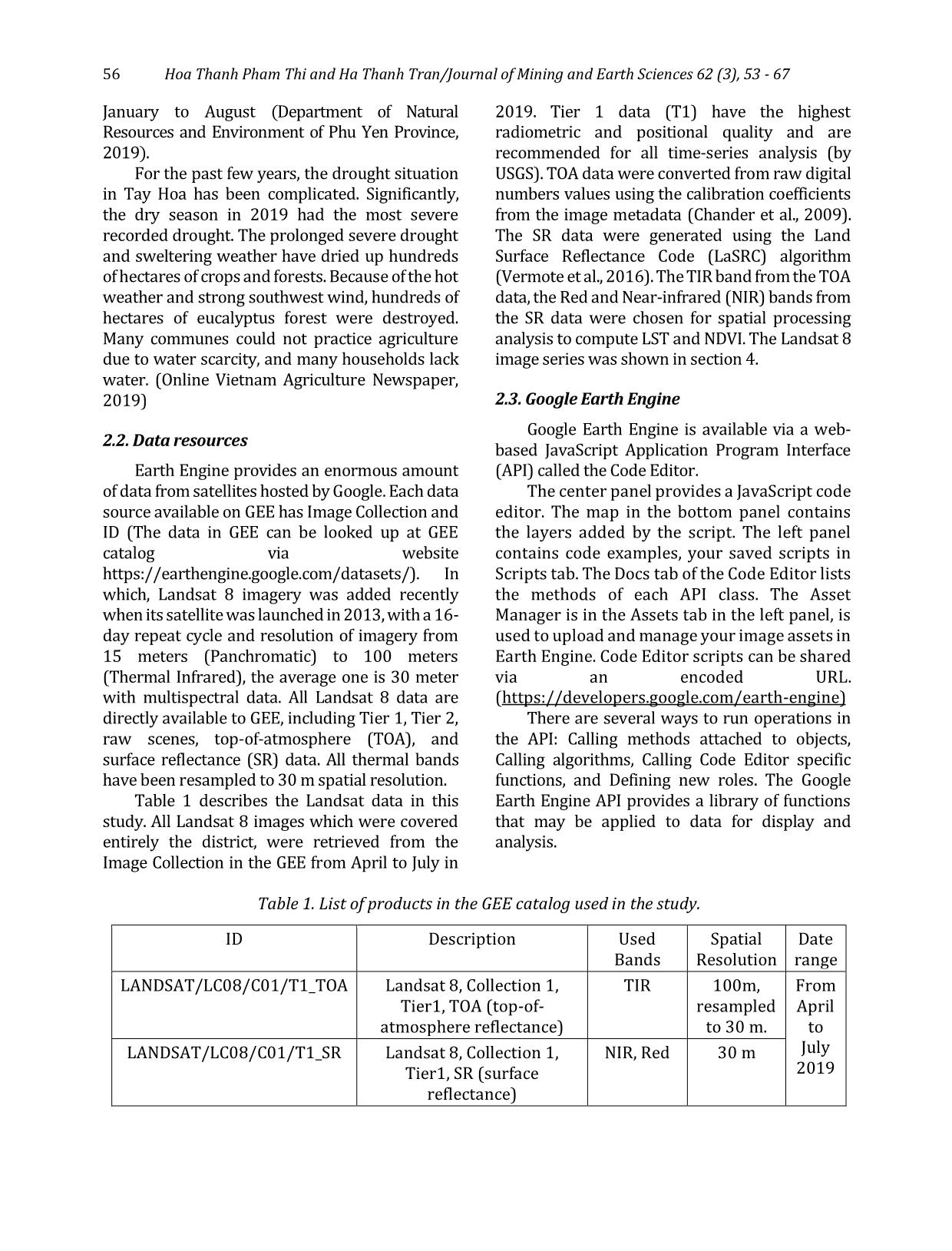
Trang 4

Trang 5

Trang 6
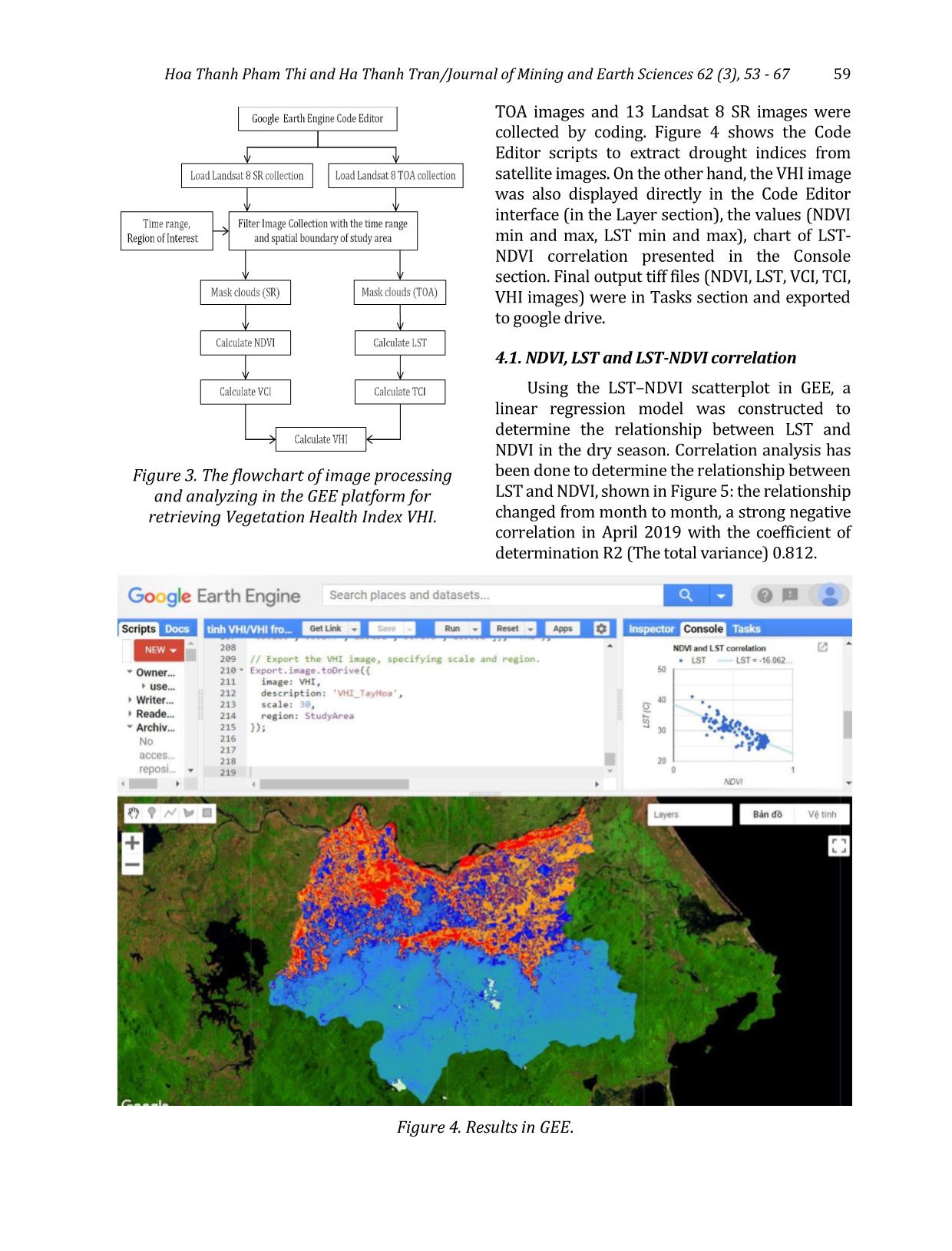
Trang 7
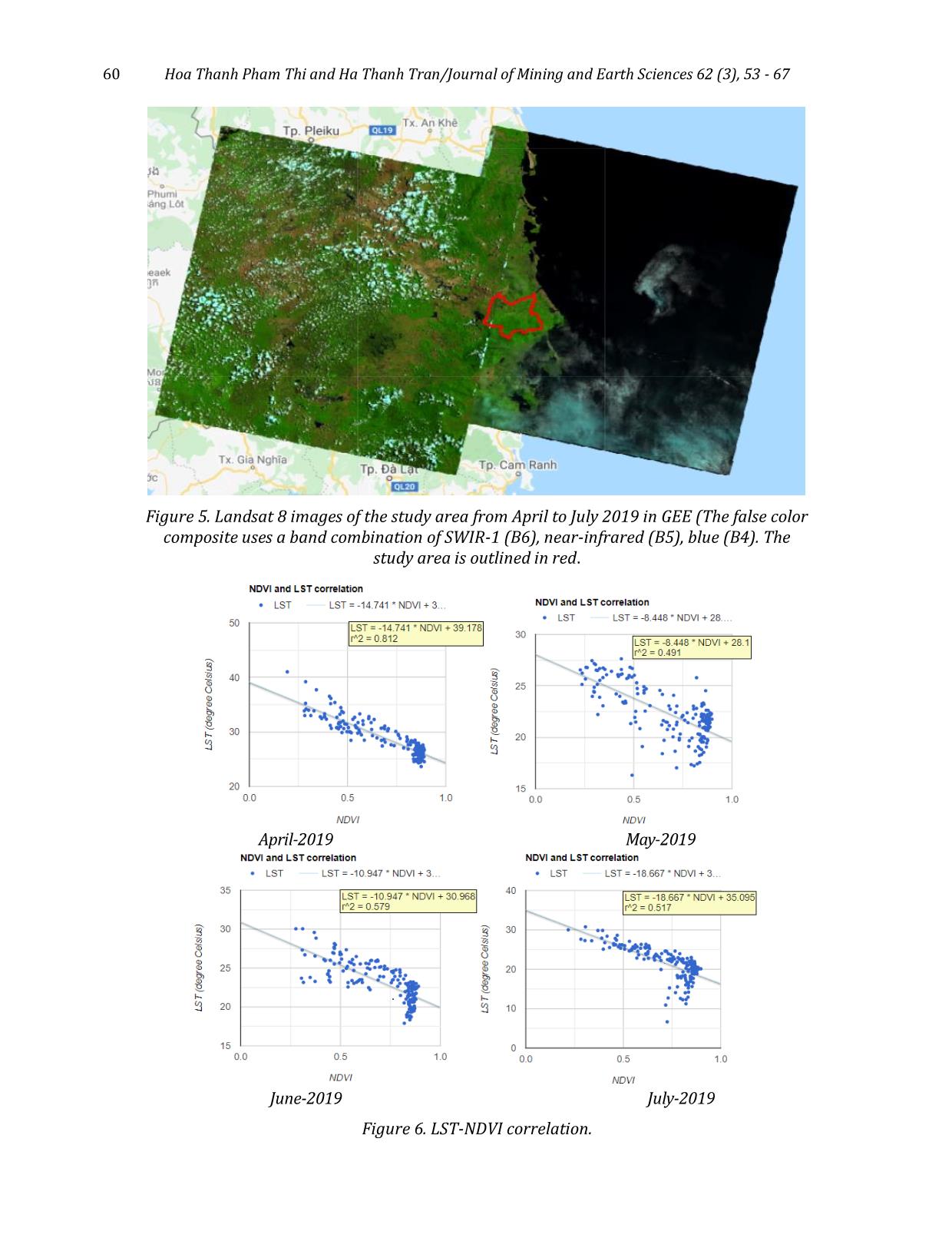
Trang 8
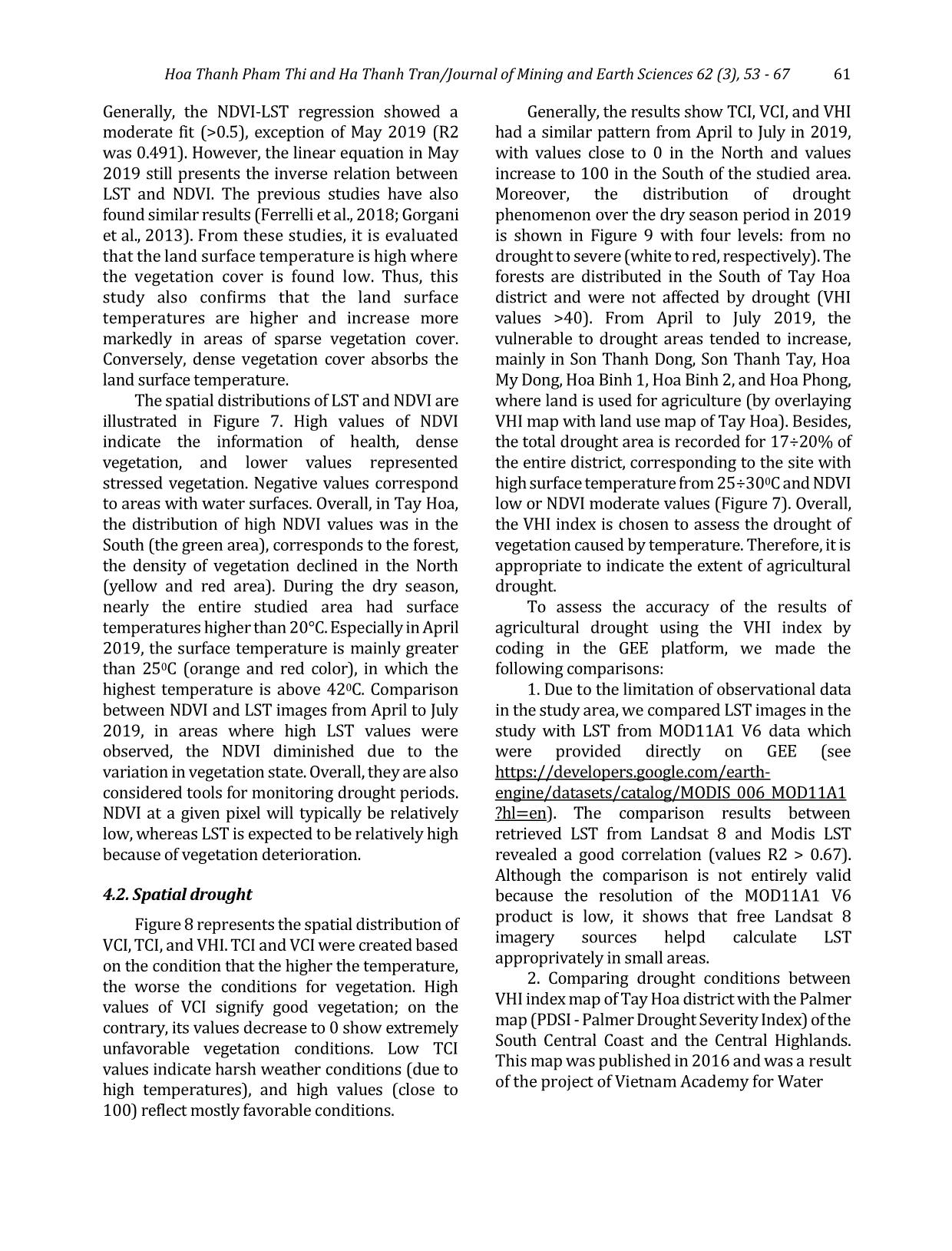
Trang 9
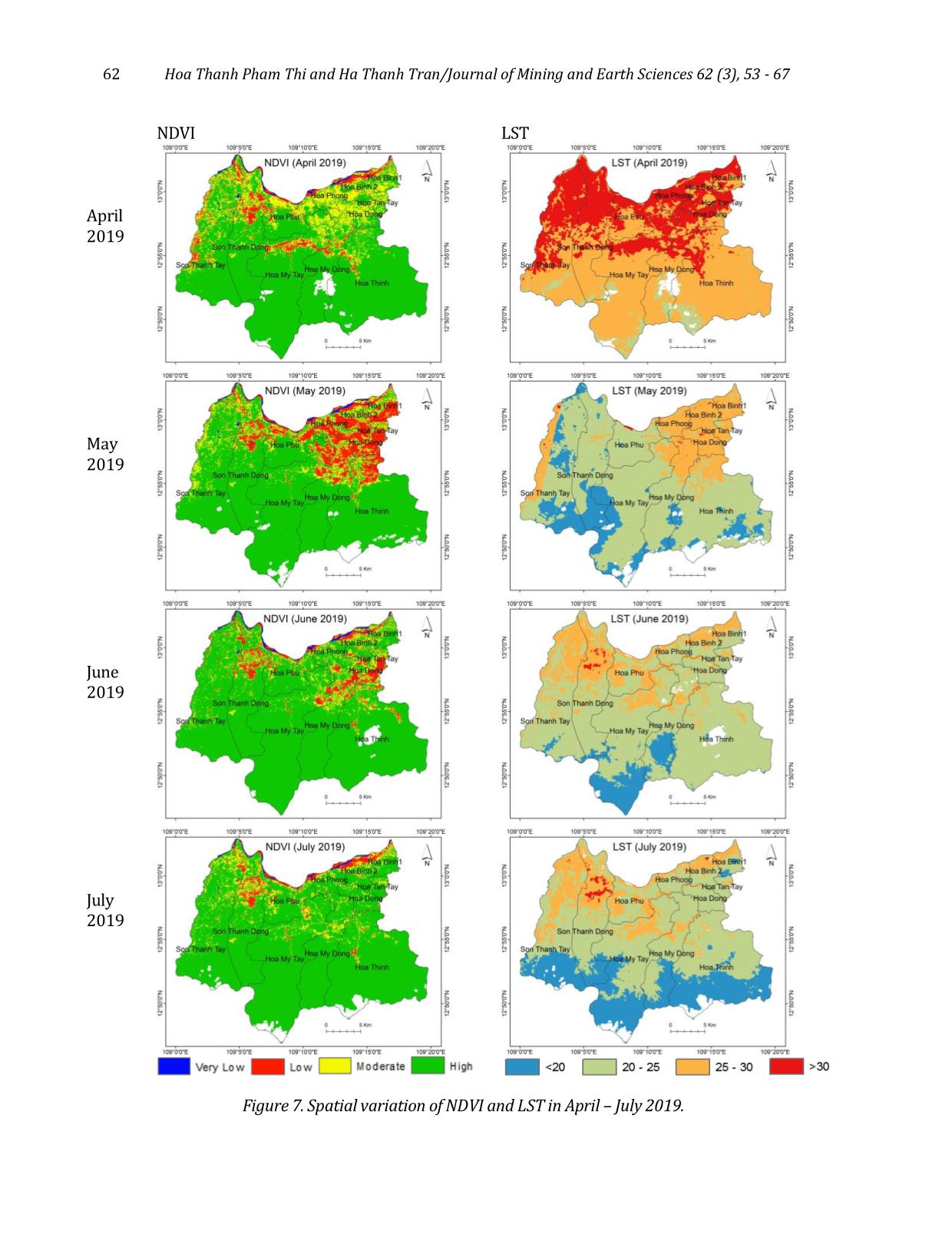
Trang 10
Tải về để xem bản đầy đủ
Tóm tắt nội dung tài liệu: Application of remote sensing imagery and algorithms in Google earth engine platform for drought assessment
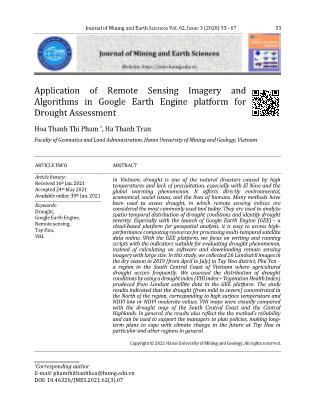
Journal of Mining and Earth Sciences Vol. 62, Issue 3 (2020) 53 - 67 53 Application of Remote Sensing Imagery and Algorithms in Google Earth Engine platform for Drought Assessment Hoa Thanh Thi Pham *, Ha Thanh Tran Faculty of Geomatics and Land Administration, Hanoi University of Mining and Geology, Vietnam ARTICLE INFO ABSTRACT Article history: Received 16th Jan. 2021 Accepted 24th May 2021 Available online 30th Jun. 2021 In Vietnam, drought is one of the natural disasters caused by high temperatures and lack of precipitation, especially with El Nino and the global warming phenomenon. It affects directly environmental, economical, social issues, and the lives of humans. Many methods have been used to assess drought, in which remote sensing indices are considered the most commonly used tool today. They are used to analyze spatio-temporal distribution of drought conditions and identify drought severity. Especially with the launch of Google Earth Engine (GEE) - a cloud-based platform for geospatial analysis, it is easy to access high- performance computing resources for processing multi-temporal satellite data online. With the GEE platform, we focus on writing and running scripts with the indicators suitable for evaluating drought phenomenon, instead of calculating on software and downloading remote sensing imagery with large size. In this study, we collected 26 Landsat 8 images in the dry season in 2019 (from April to July) in Tay Hoa district, Phu Yen – a region in the South Central Coast of Vietnam where agricultural drought occurs frequently. We assessed the distribution of drought conditions by using a drought index (VHI index – Vegetation Health Index) produced from Landsat satellite data in the GEE platform. The study results indicated that the drought (from mild to severe) concentrated in the North of the region, corresponding to high surface temperature and NDVI low or NDVI moderate values. VHI maps were visually compared with the drought map of the South Central Coast and the Central Highlands. In general, the results also reflect the the method’s reliability and can be used to support the managers to plan policies, making long- term plans to cope with climate change in the future at Tay Hoa in particular and other regions in general. Copyright © 2021 Hanoi University of Mining and Geology. All rights reserved. Keywords: Drought, Google Earth Engine, Remote sensing, Tay Hoa, VHI. _____________________ *Corresponding author E-mail: phamthithanhhoa@humg.edu.vn DOI: 10.46326/JMES.2021.62(3).07 54 Hoa Thanh Pham Thi and Ha Thanh Tran/Journal of Mining and Earth Sciences 62 (3), 53 - 67 1. Introduction In recent times, climate change are the main reasons which caused global warming, the lack of rainfall, making the drought more serious. This phenomenon greatly impacts agriculture such as reducing crop productivity, reducing cultivated areas and crop yields, mainly food crops. Therefore, identifying of drought extent is considered an important program to assess the drought occurrence and its severity to agriculture development in Vietnam. Although drought types occur at different timescales as usual, it is detected in the dry season with precipitation shortages, high temperatures (Wilhite, 2000). Besides, it often happens in large areas. Therefore, many scientists worldwide have recognized the potential of using indices observed from remote sensing data to monitor drought effectively. The main reason was given as remote sensing technology provides a synoptic view of the Earth’s surface. The advantage of technology is that image data is delivered continuously over time and whole the globe, so the details of the results are shown legibly with different regions, more efficient than the measurement with the monitoring point. The use of remote sensing data to establish drought maps will provide an overview of the space of drought areas for the regions where there are no or few meteorological stations and there is a variety of free satellite imagery suitable for evaluating drought conditions, such as MODIS and LANDSAT. Among drought indices derived from remote sensing data, the Normalized Difference Vegetation Index (NDVI) combined with Land Surface Temperature (LST) provides a strong correlation. It gives valuable information to identify agricultural drought (Sruthi et al., 2015). Based on NDVI and LST relationship, many drought indices were introduced, such as Temperature – Vegetation Dryness Index (TVDI), Vegetation Health Index (VHI), Water Supplying Vegetation Index (WSVI), and tested successfully in many countries (Alshaikh, 2015; Schirmbeck et al., 2017; Sholihah et al., 2016). VHI demonstrated a greater capability and better suitability in monitoring drought (Bento et al., 2018). It combines two indices: Veget ... ation state. Overall, they are also considered tools for monitoring drought periods. NDVI at a given pixel will typically be relatively low, whereas LST is expected to be relatively high because of vegetation deterioration. 4.2. Spatial drought Figure 8 represents the spatial distribution of VCI, TCI, and VHI. TCI and VCI were created based on the condition that the higher the temperature, the worse the conditions for vegetation. High values of VCI signify good vegetation; on the contrary, its values decrease to 0 show extremely unfavorable vegetation conditions. Low TCI values indicate harsh weather conditions (due to high temperatures), and high values (close to 100) reflect mostly favorable conditions. Generally, the results show TCI, VCI, and VHI had a similar pattern from April to July in 2019, with values close to 0 in the North and values increase to 100 in the South of the studied area. Moreover, the distribution of drought phenomenon over the dry season period in 2019 is shown in Figure 9 with four levels: from no drought to severe (white to red, respectively). The forests are distributed in the South of Tay Hoa district and were not affected by drought (VHI values >40). From April to July 2019, the vulnerable to drought areas tended to increase, mainly in Son Thanh Dong, Son Thanh Tay, Hoa My Dong, Hoa Binh 1, Hoa Binh 2, and Hoa Phong, where land is used for agriculture (by overlaying VHI map with land use map of Tay Hoa). Besides, the total drought area is recorded for 17÷20% of the entire district, corresponding to the site with high surface temperature from 25÷300C and NDVI low or NDVI moderate values (Figure 7). Overall, the VHI index is chosen to assess the drought of vegetation caused by temperature. Therefore, it is appropriate to indicate the extent of agricultural drought. To assess the accuracy of the results of agricultural drought using the VHI index by coding in the GEE platform, we made the following comparisons: 1. Due to the limitation of observational data in the study area, we compared LST images in the study with LST from MOD11A1 V6 data which were provided directly on GEE (see https://developers.google.com/earth- engine/datasets/catalog/MODIS_006_MOD11A1 ?hl=en). The comparison results between retrieved LST from Landsat 8 and Modis LST revealed a good correlation (values R2 > 0.67). Although the comparison is not entirely valid because the resolution of the MOD11A1 V6 product is low, it shows that free Landsat 8 imagery sources helpd calculate LST approprivately in small areas. 2. Comparing drought conditions between VHI index map of Tay Hoa district with the Palmer map (PDSI - Palmer Drought Severity Index) of the South Central Coast and the Central Highlands. This map was published in 2016 and was a result of the project of Vietnam Academy for Water 62 Hoa Thanh Pham Thi and Ha Thanh Tran/Journal of Mining and Earth Sciences 62 (3), 53 - 67 NDVI LST April 2019 May 2019 June 2019 July 2019 Figure 7. Spatial variation of NDVI and LST in April – July 2019. Hoa Thanh Pham Thi and Ha Thanh Tran/Journal of Mining and Earth Sciences 62 (3), 53 - 67 63 VCI TCI April 2019 May 2019 June 2019 July 2019 Figure 8. VCI and TCI in Tay Hoa district in dry season 2019. 64 Hoa Thanh Pham Thi and Ha Thanh Tran/Journal of Mining and Earth Sciences 62 (3), 53 - 67 Resource. While VHI uses LST and NDVI extracted from remote sensing for monitoring agricultural drought, PDSI uses readily available temperature and precipitation data series (Alley, 1984; Palmer, 1965). The drought in 2016 occurred in most provinces of the south - central coast and the central highlands in general and Tay Hoa district in particular, while the drought results in 2019 in the study mainly occurred in the northern regions of Tay Hoa. Although there are no similarities in space, time and index, the comparison is also found that drought area in 2019, also existed in 2016. Besides, we overlayed the VHI map with the land use map of Tay Hoa. Therefore, the results of the areas identified as drought are consistent with the reality of crop regions. Overall, the results also reflect the method’s reliability, especially in the absence of meteorological information in the area. 5. Conclusion This study assessed drought conditions in a relatively small rural area in the south - central coastal of Vietnam during the dry season. The method relies on Google Earth Engine and algorithms/scripts to analyze and calculate the Vegetation Health Index (VHI) - drought index. Our results confirm that from April to July 2019, the preliminary information about the spatial distribution of mild, moderate, and severe drought in the Tay Hoa district was provided quickly. Futhermore, it shows the potential of using GEE to monitor drought. The GEE data catalog includes all the Landsat imagery and replaces all the heavy computational processes with advanced cloud computing technologies, the results obtained for a short time. The Google Earth Figure 9. Spatial distribution of drought with VHI index. Hoa Thanh Pham Thi and Ha Thanh Tran/Journal of Mining and Earth Sciences 62 (3), 53 - 67 65 Engine methodology that we developed in this research will contribute to assessing and monitoring drought for Tay Hoa district. However, this method also has the disadvantages: it depends on selecting of suitable Landsat 8 images for the study area. Images with a large cloud cover will not be selected because the information about drought at this time will be lost. Therefore, to solve this combining different types of satellite imagery in GEE (Landsat, Sentinel, Modis) and adding the parameters to indicate drought conditions, such as water capacity and rainfall. Acknowledgment The authors would like to thank the Hanoi University of Mining and Geology for funding this research in Project No T20-10. Author contributions Pham Thi Thanh Hoa: Conceived the idea, performed the analytic calculations, wrote the manuscript. Tran Thanh Ha: analyzed the data and formulas, commented and edited this manuscript. References Aksoy, S., Gorucu, O.,Sertel, E., (2019). Drought Monitoring using MODIS derived indices and Google Earth Engine Platform. Paper presented at the 2019 8th International Conference on Agro-Geoinformatics (Agro-Geoinformatics). 1- 6. doi: 10.1109/Agro- Geoinformatics.2019.8820209. Alley, W., (1984). The Palmer Drought Severity Index: Limitations and Assumptions. Journal of Climate and Applied Meteorology, 23, 1100- 1109. doi: 10.1175/1520- 0450(1984)0232.0.CO;2. Alshaikh, A. Y., (2015). Space applications for drought assessment in Wadi-Dama (West Tabouk), KSA. The Egyptian Journal of Remote Sensing and Space Science, 18(1, Supplement 1), S43-S53. doi: https://doi.org/10.1016/j.ejrs.2015.07.001. Bento, V., Gouveia, C., Dacamara, C.,Trigo, I., (2018). A climatological assessment of drought impact on vegetation health index. Agricultural and Forest Meteorology, 259, 286- 295. doi: 10.1016/j.agrformet.2018.05.014. Chander, G., Markham, B. L.,Helder, D. L., (2009). Summary of current radiometric calibration coefficients for Landsat MSS, TM, ETM+, and EO-1 ALI sensors. Remote Sensing of Environment, 113(5), 893-903. doi: https://doi.org/10.1016/j.rse.2009.01.007. Department of Natural Resources and Environment of Phu Yen Province, (2019). Climate assessment reports of Phu Yen province (in Vietnamese). DeVries, B., Huang, C., Armston, J., Huang, W., Jones, J.,Lang, M., (2020). Rapid and robust monitoring of flood events using Sentinel-1 and Landsat data on the Google Earth Engine. Remote Sensing of Environment, 240. doi: 10.1016/j.rse.2020.111664. Ferrelli, F., Huamantinco Cisneros, M., Delgado, A.,Piccolo, M., (2018). Spatial and temporal analysis of the LST-NDVI relationship for the study of land cover changes and their contribution to urban planning in Monte Hermoso, Argentina. Documents d'Anàlisi Geogràfica, 64, 25. doi: 10.5565/rev/dag.355. Gorelick, N., Hancher, M., Dixon, M., Ilyushchenko, S., Thau, D.,Moore, R., (2017). Google Earth Engine: Planetary-scale geospatial analysis for everyone. Remote Sensing of Environment, 202, 18-27. doi: https://doi.org/10.1016/j.rse.2017.06.031. Gorgani, S., Panahi, M.,Rezaie, F., (2013). The Relationship between NDVI and LST in the urban area of Mashhad, Iran. Paper presented at the International Conference on Civil Engineering Architecture & Urban Sustainable Development. At Tabriz , Iran. Khan, R., Gilani, H., Iqbal, N.,Shahid, I., (2019). Satellite-based (2000–2015) drought hazard assessment with indices, mapping, and monitoring of Potohar plateau, Punjab, Pakistan. Environmental Earth Sciences, 79(1), 23. doi: 10.1007/s12665-019-8751-9. Kogan, F. N., (1995). Application of vegetation index and brightness temperature for drought detection. Advances in Space Research, 15(11), 66 Hoa Thanh Pham Thi and Ha Thanh Tran/Journal of Mining and Earth Sciences 62 (3), 53 - 67 91-100. doi: https://doi.org/10.1016/0273- 1177(95)00079-T. Kogan, F. N., (2000). Satellite-Observed Sensitivity of World Land Ecosystems to El Niño/La Niña. Remote Sensing of Environment, 74, 445-462. doi: 10.1016/S0034-4257(00)00137-1. Long, V. H., Giang, N. V., Hoanh, T. P.,Hoa, P. V., (2019). Applying Google Earth Engine in river bank erosion monitoring – a case study in lower Mekong river (in Vietnamese). Journal of science- Ho Chi Minh city University of Education. Masitoh, F.,Rusydi, A. N., (2019). Vegetation Health Index (VHI) analysis during drought season in Brantas Watershed. IOP Conference Series: Earth and Environmental Science, 389, 012033. doi: 10.1088/1755- 1315/389/1/012033. Midekisa, A., Holl, F., Savory, D. J., Andrade- Pacheco, R., Gething, P. W., Bennett, A.,Sturrock, H. J. W., (2017). Mapping land cover change over continental Africa using Landsat and Google Earth Engine cloud computing. PLOS ONE, 12(9), e0184926. doi: 10.1371/journal.pone.0184926. Mutanga, O.,Kumar, L., (2019). Google Earth Engine Applications. Remote Sensing, 11, 591. doi: 10.3390/rs11050591. Nguyen Trong Nhan,Cuong, V. X., (2018). Google Earth Engine was applied to forest land monitoring in Lam Dong province from 2010 - 2016 (in Vietnamese). The fourth Scientific Conference - SEMREGG 2018, 258-265. Nguyen Viet Lanh, Dung, N. V., Duong, T. H.,Tam, T. T., (2018). Using satellite precipitation data to assess meteorological drought based on SPI index for Thanh Hoa province. Vietnam Journal of Hydro - Meteorology, 696, 1-9. Nhut, H. S., Hoa, P. V., Binh, N. A., An, N. N., Phuong, T. A.,Thao, G. T. P., (2018). Using Google Earth Engine for assessing mangrove forest change in Ngoc Hien district, Ca Mau province in the period 2000-2015 (in Vietnamese). Journal of science- Ho Chi Minh city University of Education, 15(11b), 101-107. Online Vietnam Agriculture Newspaper. (2019). https://nongnghiep.vn/phu-yen-han-han- khoc-liet-mot-xa-thieu-nuoc-nghiem-trong- d247764.html. Palmer, W. C., (1965). Meteorological Drought. Research Paper No. 45, US Weather Bureau, Washington, DC. Sazib, N., Mladenova, I.,Bolten, J., (2018). Leveraging the Google Earth Engine for Drought Assessment Using Global Soil Moisture Data. Remote Sensing, 10, 1265. doi: 10.3390/rs10081265. Schirmbeck, L. W., Fontana, D. C., Schirmbeck, J.,Mengue, V. P., (2017). Understanding TVDI as an index that expresses soil moisture. Journal of Hyperspectral Remote Sensing, 7, 82-90. Sholihah, R., Trisasongko, B., Shiddiq, D., Iman, L. O., Kusdaryanto, S., Manijo,Panuju, D., (2016). Identification of Agricultural Drought Extent Based on Vegetation Health Indices of Landsat Data: Case of Subang and Karawang, Indonesia. Procedia Environmental Sciences, 33, 14-20. doi: 10.1016/j.proenv.2016.03.051 Sidhu, N., Pebesma, E.,Câmara, G., (2018). Using Google Earth Engine to detect land cover change: Singapore as a use case. European Journal of Remote Sensing, 51, 486-500. doi: 10.1080/22797254.2018.1451782 Sobrino, J. A., Jiménez-Muñoz, J. C.,Paolini, L., (2004). Land surface temperature retrieval from LANDSAT TM 5. Remote Sensing of Environment, 90(4), 434-440. doi: https://doi.org/10.1016/j.rse.2004.02.003. Sreekesh, S., Kaur, N.,Sreerama Naik, S. R., (2019). Agricultural drought and soil moisture analysis using satellite image based indices. Int. Arch. Photogramm. Remote Sens. Spatial Inf. Sci., XLII-3/W6, 507-514. doi: 10.5194/isprs- archives-XLII-3-W6-507-2019. Sruthi, S.,Aslam, M. A. M., (2015). Agricultural Drought Analysis Using the NDVI and Land Surface Temperature Data; a Case Study of Raichur District. Aquatic Procedia, 4, 1258- 1264. doi: https://doi.org/10.1016/j.aqpro.2015.02.164 Hoa Thanh Pham Thi and Ha Thanh Tran/Journal of Mining and Earth Sciences 62 (3), 53 - 67 67 Sunar, F., Yağmur, N.,Dervisoglu, A., (2019). Flood Analysis with Remote Sensing Data - a Case Study: Maritsa River, Edirne. ISPRS - International Archives of the Photogrammetry, Remote Sensing and Spatial Information Sciences, XLII-3/W8, 497-502. doi: 10.5194/isprs-archives-XLII-3-W8-497-2019. Tran, H. T., Campbell, J. B., Tran, T. D.,Tran, H. T., (2017). Monitoring drought vulnerability using multispectral indices observed from sequential remote sensing (Case Study: Tuy Phong, Binh Thuan, Vietnam). GIScience & Remote Sensing, 54(2), 167-184. doi: 10.1080/15481603.2017.1287838. Tuan, V. Q., Khai, D. H., Nhan, H. T. K.,Hoa, N. T., (2018). Development of flood monitoring algorithms in the Mekong Delta based on Google Earth Engine platform (in Vietnamese). Can Tho University Journal of Science, 54(9A), 29-36. Tucker, C. J., (1979). Red and photographic infrared linear combinations for monitoring vegetation. Remote Sensing of Environment, 8(2), 127-150. doi: https://doi.org/10.1016/0034- 4257(79)90013-0. Vermote, E., Justice, C., Claverie, M.,Franch, B., (2016). Preliminary analysis of the performance of the Landsat 8/OLI land surface reflectance product. Remote Sensing of Environment, Volume 185(Iss 2), 46-56. doi: 10.1016/j.rse.2016.04.008. Weng, Q., Lu, D.,Schubring, J., (2004). Estimation of land surface temperature–vegetation abundance relationship for urban heat island studies. Remote Sensing of Environment, 89(4), 467-483. doi: https://doi.org/10.1016/j.rse.2003.11.005. Wilhite, D., (2000). Drought as a Natural Hazard: Concepts and Definitions. Drought, a Global Assessment, 1.
File đính kèm:
 application_of_remote_sensing_imagery_and_algorithms_in_goog.pdf
application_of_remote_sensing_imagery_and_algorithms_in_goog.pdf

